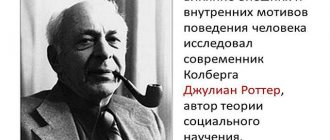Deduction is a method of thinking, the consequence of which is a logical conclusion, where a particular conclusion is deduced from a general one.
“From just one drop of water, a person who knows how to think logically can deduce the existence of the Atlantic Ocean or Niagara Falls, even if he has not seen either one or the other,” this is how the most famous literary detective reasoned. Taking into account small details invisible to other people, he built impeccable logical conclusions using the method of deduction. It was thanks to Sherlock Holmes that the whole world learned what deduction is. In his reasoning, the great detective always started from the general picture - the whole picture of the crime with the alleged criminals, and moved to specific moments - he considered each individual, everyone who could commit the crime, studied the motives, behavior, evidence.
This amazing Conan Doyle hero could guess from the soil particles on his shoes which part of the country a person came from. He also distinguished one hundred and forty types of tobacco ash. Sherlock Holmes was interested in absolutely everything and had extensive knowledge in all areas.
What is the deductive method?
The deductive method (from Latin deductio - deduction) is a method of thinking , the consequence of which is a logical conclusion, where a particular conclusion is deduced from the general. The whole essence of the deductive method is that a person begins to build a logical chain based on a hypothesis, the accuracy of which he has no doubt. In order to prove a hypothesis, it is necessary to make observations and draw conclusions. In the process of observation, generally accepted and recognized facts are applied.
To make it easier to understand what the deductive method is, let's turn to the book “Thinking Slow... Solve Fast,” authored by Nobel Prize winner Daniel Kahneman. The book describes the so-called “fast thinking,” which is responsible for instantaneous awareness of the surrounding space. This type of thinking forces a person to classify his instinctive sensations. Based on this, a person most often makes irrational decisions that turn out to be wrong.
In order to ensure the conscious formation of thoughts, decisions, conclusions and assessments, it is necessary to use a system of “slow” thinking. How does this manifest itself? For example, a woman found her husband's wedding ring on the living room table. The first impulse, of course, will be to get angry with your spouse and suspect him of all mortal sins. However, the woman immediately remembers that a light bulb in their living room had burned out, and she asked her husband to replace it. The light in the room is on, which means the man has fulfilled the request. It follows that he had to bring a stepladder and tools from the garage. Because the man had to wear gloves, he took off the ring to make it easier for him. Afterwards, he simply forgot to put it on because he was late for work. The reason was found, a family quarrel was avoided - this is an example of “slow” thinking, which helped the woman see all the details and come to the right conclusion.
This type of thinking is the basis of the deductive method. Deduction allows you to draw a particular conclusion based on general facts. Let's take the same gold ring. We know that all metals are capable of conducting current, and gold is undoubtedly a metal. From this we can conclude that a gold ring is also capable of passing current. We applied knowledge from the general education school curriculum and made a private conclusion. In doing so, we used the deductive method of thinking.
Basic output forms
Let's consider the basic forms of reasoning characteristic of logical thinking. There are not so many such forms: these are induction, deduction and analogy. They can be briefly characterized as follows.
Induction is an inference about a set based on consideration of the individual elements of that set.
In contrast, deduction is an inference about an element based on knowledge of certain qualities of the set in which it is included.
An analogy is an inference about an element (set) that conveys to it the properties of another element (set). Let's look at each method separately.
Examples of the deductive method
Deductive thinking has been around since the time of Aristotle, who analyzed every conclusion along with its premises and conclusion. Cognition through the deductive method is based on the relationship of the constituent components.
Let's go back to the example with the gold ring. Hypothesis A states that all metals carry current. If this hypothesis is correct, then hypothesis B that gold, like a metal, also passes current, is correct. So the B hypothesis follows from the A hypothesis. If someone manages to prove that gold does not transmit current, then this will mean that hypothesis B is incorrect. From this we can conclude that judgment A will also be erroneous.
Judgments that contain statements of immutable truths are premises. In our example, these are “metals pass current” and “gold is a metal.” Judgments that follow from the premises and put a logical point are a conclusion, or a consequence. “Gold also passes current”—that’s the conclusion.
Abduction concept
Abduction is an independent offshoot of the stage of scientific research, which asks the general question: “In what way can a person create a true and testable theory about the world around him?” How did certain judgments appear in the human mind, on the basis of what thought processes and data?
One of the leading representatives of analytical philosophy, Charles Peirce, identifies abduction as one of the main classes for constructing a conclusion (together with induction and deduction). It brings together all work activities that create new theories and concepts.
Deduction proves that the predicted result is an obvious consequence of the operation of the general rule in relation to a specific case. Abduction allows you to build a new explanatory hypothesis on the basis of a general rule and an identified fact.
Differences from the inductive method
The inductive method is the exact opposite of the deductive method, and is based on the transition from the particular to the general. This can be observed more clearly in medicine, when a doctor, based on the patient’s symptoms, makes a diagnosis. From a deductive point of view, the whole “picture” must first be assessed in order to reach a correct conclusion. Using this method, the doctor must first use the general term “cold” and work from there. Influenza means that a person must have symptoms.
If we talk about differences, it should be mentioned that deductive thinking is more generalizing and global. Inductive thinking is based on subjective hunches. However, both methods are interrelated. At the beginning, until a common feature is discovered in various phenomena, the movement occurs from the particular to the general, that is, induction is used. By combining particular cases, induction allows us to obtain general knowledge. After establishing a general feature, thinking goes in the opposite direction - from the general to the specific. This is a deductive method.
Deduction and induction
When the mind is prepared and saturated with various useful information, you can move on to exercises for the development of logical thinking: deductive and inductive. After all, Conan Doyle’s character used both methods, which, alas, is shown in the BBC series “Sherlock” somewhat weaker than in the books of Arthur Conan Doyle.
Deduction is a method in which the particular is logically deduced from the general: “All metals conduct current. Gold is a metal. This means gold conducts current.” Induction, on the contrary, brings the general out of the particular: “I am a Muscovite and I remember that snow fell every winter. This means that it always snows in Moscow in winter.” Sherlock Holmes, inspecting a crime scene or assessing those around him, often went from the particular to the general and back again, freely moving in both logical directions: “John has a military bearing, tanning on his arms only up to the sleeves, a psychosomatic limp, which means he has been in war. Where have there been military operations recently? In Afghanistan. So, in the war in Afghanistan.”
However, his main conclusions were deductive and arose in the head of the great detective when he was tormenting his violin or thinking while smoking a pipe. At these moments, Sherlock Holmes turned to his phenomenal knowledge of history and criminology and classified the case based on the “family tree of crimes.” He assigned him a place in the group: “Murder over an inheritance,” “Murder out of jealousy,” “Theft of a will,” etc. This provided a motive, and the motive provided suspects. This was the essence of Sherlock Holmes' deductive method. Induction gave him food for thought, while deduction gave him the answer.
There are many exercises to train logical thinking. For example, “Concepts in order”, within which it is necessary to arrange several words from particular meanings to general ones or vice versa. Chess or poker may also be useful. In addition, it is important to learn to avoid logical errors in judgments, having studied them, for example, in the book by Avenir Uemov “Logical errors. How they prevent you from thinking correctly.”
Where is deduction used?
Every day, when faced with various circumstances, our brain builds logical chains that are invisible to many. When deciding what to wear in the morning, we study the weather outside the window. We have two messages in our heads: it’s cold outside, and warm clothes protect us from the cold. These are two general knowledges. Based on this, we come to the understanding that we need to dress warmly - this is the conclusion.
The deductive method is present in our everyday life, but we may not understand it. However, when it comes to professional activities, a person consciously uses deduction to solve specific problems. The method of deductive thinking is used in many directions:
- disputes and discussions - using deduction, obvious statements are given with which the opponent has to agree, thereby accepting your point of view;
- mathematics - a good example is geometric problems from the school curriculum. To prove the theorem, the student must use generally accepted and proven axioms;
- philosophy - the whole essence of the deduction method here is that any hypothesis must be substantiated using only logical evidence;
- forensics - upon arriving at the crime scene, the expert uses the overall picture of the incident. This helps him find individual circumstances and new details;
- science - a scientist takes as the basis of his work some hypothesis that has not yet been proven or disproven. Based on the hypothesis, the scientist derives consequences that he will try to discover during the research.
How to raise a detective in yourself
To learn to notice details, interpret them correctly and not get distracted during observations and analysis, you will need exercises to develop voluntary and involuntary attention, as well as training in flexibility of thinking.
Involuntary attention is a system of reaction to stimuli, a kind of “lateral vision” with regard to the perception of reality. To develop it, you can make it a rule to observe familiar objects and places with a lack of lighting and different sound backgrounds (in natural conditions, with pleasant music and with sharp unpleasant sounds), and also get used to noting details that attract attention when moving from one view to another. activities to others. This allows you to cultivate sensitivity to fluctuations in reality and learn not to miss curious details that may turn out to be the key to a situation or a person’s character.
Voluntary attention, or simply concentration, also plays a huge role in cultivating the ability to think clearly. On average, thanks to volitional effort, a person is able to maintain attention on an object for only 20 minutes. To increase this indicator, training with the so-called “Entertaining Table” and its analogues is suitable. Each such table is a structure with chaotically located and differently depicted numbers from 1 to 35 or from 1 to 90. The task is to find all the numbers in ascending or descending order, spending the least amount of time on this.
You can also train attention to detail by making it a habit to observe strangers: at work, on the street, on social networks. In this case, it is important to evaluate a person from different angles, giving several options for answering questions about what profession he can engage in, what his marital status is, character and habits. This will allow you to develop flexibility of thinking and stop each time being satisfied with a single answer option, which may be more likely to be incorrect.
However, the main secret of devilish observation seems to lie not in the amount of training, but in the presence of strong interest. Indeed, with an increase in the emotional value of the subject of study and the emergence of work experience sufficient to automate actions, a person develops so-called post-voluntary attention, the focus of which can not weaken for hours. It was post-voluntary attention that allowed Sherlock Holmes to solve crimes. It also helps scientists make discoveries, writers find the best formulations, etc. In addition, the presence of post-voluntary attention is also pleasant: it relieves the psyche, since the brain stops wasting energy on maintaining focus and can devote energy to solving the tasks at hand.
How to learn to think deductively?
We've talked before about the slow mindset. If you want to learn the deductive method, you will need to be observant. Be “corrosive”, try to pay attention to even the most inconspicuous details. Start small, for example, by studying the arrangement of furniture in a room when you are visiting someone. When talking to a person, pay attention to how he talks, gestures, and where he looks. Over time, you will learn to notice what is hidden from prying eyes.
If you don't have a small notebook, now is the time to buy one. Carry it with you always to record all your observations. Over time, spatial descriptions will turn into iron facts. Don't forget that you will need an extensive knowledge base. Expand your horizons every day: read, watch films and listen to music of different genres, travel, meet people of different professions and interests.
Tips for developing deduction
So, deductive abilities should be developed in conjunction with logical thinking. It is very important to be patient and attentive here. Deduction does not tolerate haste; its methods can be compared to unraveling a ball of thread. If you make one careless movement, the knot becomes tighter. To train deductive abilities, it is important to follow several rules.
Tasks for the development of deductive thinking
A typical task to develop the method of deductive thinking is the well-known Einstein riddle, where you are asked to guess five houses, who lives in them, what they eat, smoke and what kind of animal they keep. The task provides indirect clues. Another example of a deduction problem might be:
“A man lives in a multi-storey building, on the 15th floor. When he returns home, he takes the elevator to the 9th floor, and walks up the stairs to the 15th floor. When he returns home not alone or in rainy weather, he takes the elevator to the 15th floor. Question: why?
All objective logic tasks develop abstract thinking and working memory, the ability to search for repeating details and motives, which contributes to the development of deductive thinking.
What does the mind of Sherlock Holmes do?
Deductive method
This is the detective's main weapon, which, however, would not work without a number of additional components.
Attention
Sherlock Holmes captures even the smallest details. If not for this skill, he simply would not have material for reasoning, evidence and leads.
Knowledge base
The detective himself said it best:
All crimes show great generic similarity. They (Scotland Yard agents) introduce me to the circumstances of a particular case. Knowing the details of a thousand cases, it would be strange not to solve the thousand and one.
Sherlock Holmes
The palaces of the mind
This is his excellent memory. This is the repository that he turns to almost every time he is looking for a solution to a new riddle. This is the knowledge, circumstances and facts accumulated by Holmes, a significant part of which cannot be obtained anywhere else.
Constant analysis
Sherlock Holmes analyzes, reflects, asks questions and answers them. Often he even resorts to double analysis, it is not in vain that the detective constantly acts together with his partner Dr. Watson.
Conan Doyle's mistake
In fact, deduction is far from the main tool used by Sherlock Holmes. In general, in his books he used this method, perhaps most rarely, preferring other methods of constructing logical chains that were more suitable for the tasks of the investigation. However, we will talk about them later.
Strangely enough, some lack of education of Sir Arthur Conan Doyle, who preferred to use the definition of “deduction” in the wrong context, is to blame for everything.
The very image of Sherlock Holmes was inspired by the writer from his acquaintance at the university, who was an extremely reserved young man. This student, studying to become a pathologist, spent all his time in the morgue, among the corpses. His main hobby was examining victims of violent deaths, after autopsy of which he, as a rule, made brilliant conclusions and found evidence hidden from the eyes of the “regular” morgue workers. He passed on all his discoveries to the police, while often complaining to his friend Arthur about the lack of education and stupidity of the policemen, who were unable to solve even basic crimes.
He, like Sherlock Holmes, taught his friend Dr. Conan Doyle (of course, from whom the image of Watson was copied) what he would later immortalize in his books, giving the name “theory of deduction.”
Reviews and comments
You can rate the article and share your thoughts on the subject by posting a comment in the form below.
We also recommend reading:
- Storytelling
- How and why to develop thinking
- Traceology: when Sherlock follows a trail
- Intellectual superpowers
- The Development of Sherlock Holmes' Intuition
- How to create a colorful character
- The best blog materials in 2021: thinking development, brain training, self-education
- Questions to help you understand more
- Scientific knowledge: basics
- 10 Commandments of a Profiler
- Abduction: the search for truth through the expansion of consciousness
Key words:1Cognitive science
Is this real
It's worth starting with something encouraging.
Sherlock Holmes' abilities are absolutely real. And in general, the legendary character was copied by Conan Doyle from a living person - professor at the University of Edinburgh Joseph Bell. He was widely known for his ability to guess a person's character, background and profession from the smallest details. On the other hand, the existence of one real outstanding person does not guarantee success for everyone who tries to repeat his achievements. Mastering abilities comparable to Holmes's is incredibly difficult. In a different scenario, Scotland Yard wouldn't be running around Baker Street for clues, right?
Types of forms of knowledge.
Methods of scientific knowledge are connected not only with each other, but also with forms of knowledge.
A problem is a question that needs to be studied and resolved. Solving problems requires enormous mental effort and is associated with a radical restructuring of existing knowledge about the object. The initial form of such permission is an idea.
An idea is a form of thinking in which the most essential is captured in the most general form. The information contained in the idea is so significant for a positive solution to a certain range of problems that it seems to contain tension that encourages specification and development.
Solving a problem, like concretizing an idea, can result in the formulation of a hypothesis or the construction of a theory.
A hypothesis is a probable assumption about the cause of any phenomena, the reliability of which in the current state of production and science cannot be verified and proven, but which explains these phenomena, observed without it. Even a science like mathematics cannot do without hypotheses.
A hypothesis tested and proven in practice moves from the category of probable assumptions to the category of reliable truths and becomes a scientific theory.
A scientific theory is understood, first of all, as a set of concepts and judgments regarding a certain subject area, united into a single, true, reliable system of knowledge using certain logical principles.
Scientific theories can be classified on various grounds: by the degree of generality (particular, general), by the nature of the relationship to other theories (equivalent, isomorphic, homomorphic), by the nature of the connection with experience and the type of logical structures (deductive and non-deductive), by the nature of the use of language (qualitative, quantitative). But no matter what form theory appears today, it is the most significant form of knowledge.
The problem and idea, hypothesis and theory are the essence of the forms in which the effectiveness of the methods used in the process of cognition is crystallized. However, their significance is not only this. They also act as forms of knowledge movement and the basis for the formulation of new methods. Determining each other, acting as complementary means, they (i.e., methods and forms of cognition) in their unity provide the solution to cognitive problems and allow a person to successfully master the world around him.










